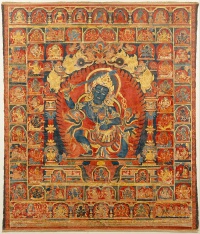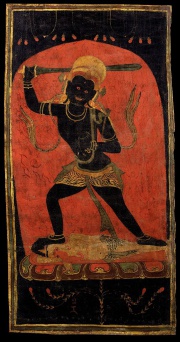Acala
- Acala (Pranidana, unerschütterliche Hingabe) ist eine der 10 Dasa-Bhumis

- Der buddhistische Weisheitskönig Acala (Skt. Ācalanātha, Āryācalanātha, Ācala-vidyā-rāja oder Caṇḍamahāroṣaṇa; Búdòng Míngwáng; jap. Fudō Myōō; Mandala : Mitte; der Unbewegliche bzw. Standfeste) wird auch im Mahavairocana-Tantra (大日経 Dainichikyō) erwähnt. Er wird als Mantrakönig(Vidyārāja, Jap. myōō) und auch als Emanation von Akshobhya angesehen.
Sein Abbild findet man in Japan häufig vor Tempeln. Acala wird dort als dreiäugige, zähnefletschendende Gestalt mit sechs Armen dargestellt und mit einem Schwert, einem Vajra, einem Beil und einer Schlinge bewaffnet.
Das Schwert hatte später oft keine Flammen und wurde als Schatzschwert (hōken) oder als Vajra-Schwert (kongō-ken) angesehen, da der Knauf des Schwertes die Form eines talonartigen Vajra (kongō-sho) hatte. Es wurde auch als dreizackiges Vajra-Schwert (sanko-ken) bezeichnet.
Acala kam zwar mit dem Vajrayana nach Japan, wo er mit Feuer-Riten (goma gyōji) in Verbindung gebracht wird. Er genießt aber auch im Shingon und im Tendai hohes Ansehen.
Ein japanisches Mantra zu Ehren von Fudō Myō-ō Sama ist "No-maku Samanda Bazara (da) Senda Makaroshada Sowataya (um) Tarata Kanman"
Ein tibetisches Mantra ist : 'Namah samatta vajranam ham'.
Ein Acalanatha - Mantra ist Namaḥ Samantavajranam Canḍa-Maharosana-Sphoṭaya Hum Traṭ Ham Mam

Literatur
- Getty, Alice (1988). The Gods of Northern Buddhism: Their History and Iconography. Courier Dover Publications. ISBN 978-0-486-25575-0.
- Louise Child (2013). Tantric Buddhism and Altered States of Consciousness, Ashgate Publishing. S. 111–112. ISBN 978-1-4094-7764-8.
- Donaldson, Thomas E. (2001). Iconography of the Buddhist Sculpture of Orissa: Text. Indira Gandhi National Centre for the Arts. pp. 219–221. ISBN 978-0-486-25575-0.
- Kinh Mật Giáo
- The secret mantra of the secret tantra of the King of All Wrathful
- 84000 : The Tantra of Caṇḍamahāroṣaṇa - Toh 431
Weblinks
- Fudo
- Fudō Myōō &Co
- Fudō Myōō
- wiki about Acala